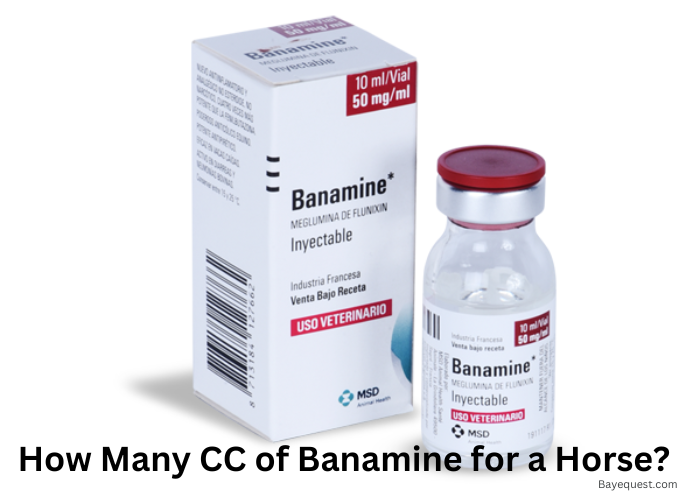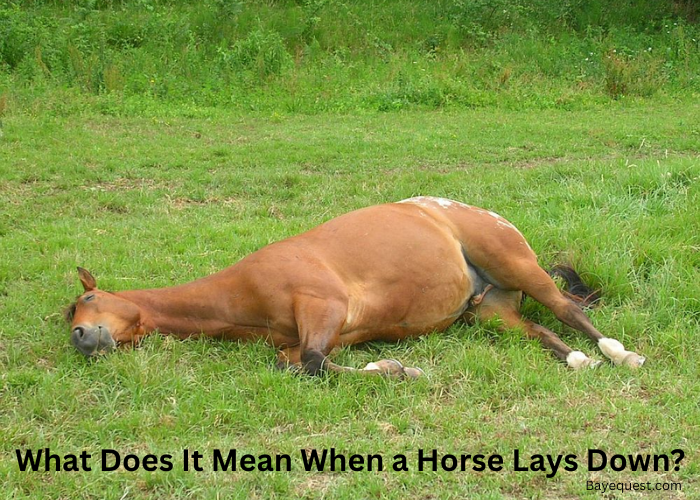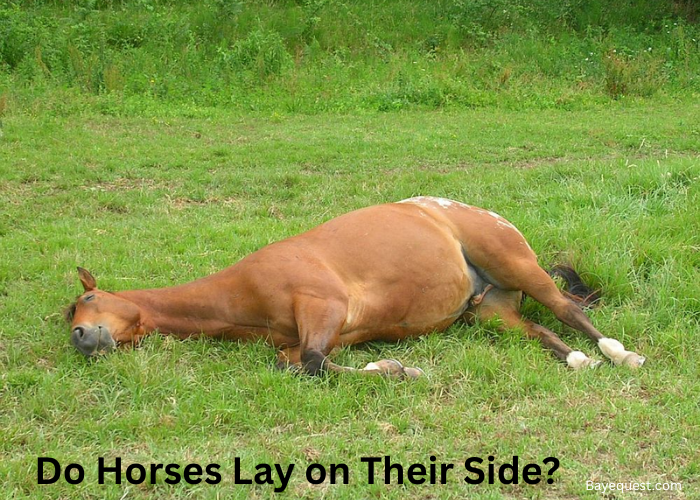Banamine is a medication used to manage pain and inflammation in horses. It’s often given for conditions like colic, fevers, or musculoskeletal issues.
Knowing the correct dosage is critical to keeping your horse safe and healthy.
Giving too much can cause serious side effects, while too little may not work effectively.
This guide will explain how many CC of Banamine your horse needs based on weight and form of the medication.
Always consult your vet before administering any drug to ensure proper care for your horse.
How Many CC of Banamine for a Horse? Key Takeaway
The standard Banamine dosage for horses is 0.5 mg per pound of body weight. For a 1,000-pound horse, this equals 10 CC of the injectable solution (50 mg/mL). Always use the correct form and follow your vet’s advice to ensure safe and effective treatment. Avoid exceeding the recommended dose.
What is Banamine?
Banamine is a non-steroidal anti-inflammatory drug (NSAID). Its active ingredient is flunixin meglumine.
It comes in injectable and oral paste forms. The injectable solution is usually 50 mg/mL in concentration.
Banamine works by reducing inflammation in the body. It’s commonly used in veterinary medicine.
Common Uses of Banamine in Horses
The most common uses of Banamine are:
1. Colic pain relief
Banamine is widely used to manage colic, one of the most common and serious conditions in horses.
It provides fast and effective pain relief, allowing time for diagnosis and additional treatments. This can be life-saving in severe cases.
2. Musculoskeletal pain
It helps reduce pain and inflammation in musculoskeletal injuries or conditions. This improves mobility and comfort, enabling the horse to recover more effectively.
3. Lameness management
Banamine is often used to manage lameness caused by issues like joint inflammation, hoof abscesses, or soft tissue injuries.
It eases pain and allows the horse to move more comfortably.
4. Fever reduction
Horses with infections or illnesses often develop high fevers. Banamine helps lower the fever, making the horse more comfortable and aiding in recovery.
5. Eye conditions
In cases of corneal ulcers or uveitis, Banamine is used to reduce inflammation and pain.
This helps protect the horse’s vision and improves their overall comfort.
6. Cellulitis relief
For horses suffering from cellulitis, Banamine alleviates the pain and swelling associated with this condition, allowing for better movement and healing.
7. Post-surgical pain management
Banamine is effective in managing pain after surgical procedures.
By reducing discomfort, it supports the horse’s recovery process and improves their quality of life during healing.
8. Anti-inflammatory benefits
Its strong anti-inflammatory properties make Banamine useful in various conditions involving swelling or inflammation.
This helps speed up the healing process and improves overall comfort.
9. Endotoxemia treatment
Banamine is commonly used in treating endotoxemia, a life-threatening condition caused by toxins in the bloodstream.
It reduces inflammation, stabilizes the horse, and improves their chances of recovery.
What is the Proper Dosage of Banamine for a Horse?
The proper dosage of Banamine for a horse is 0.5 mg per pound of body weight.
For the injectable solution, which has a concentration of 50 mg/mL, this translates to 1 CC per 100 pounds. For example, a 1,000-pound horse would require 10 CC.
The dose should be administered according to your veterinarian’s instructions and should not exceed the recommended amount.
Always measure the dosage accurately and use the form of Banamine prescribed by your vet, whether it’s injectable or oral paste.
Banamine Dosage Table Summary
| Horse Weight (lbs) | Banamine Dosage (CC) | Form of Administration |
| 500 | 5 CC | Injectable solution (IV) or oral paste |
| 600 | 6 CC | Injectable solution (IV) or oral paste |
| 700 | 7 CC | Injectable solution (IV) or oral paste |
| 800 | 8 CC | Injectable solution (IV) or oral paste |
| 900 | 9 CC | Injectable solution (IV) or oral paste |
| 1,000 | 10 CC | Injectable solution (IV) or oral paste |
| 1,100 | 11 CC | Injectable solution (IV) or oral paste |
| 1,200 | 12 CC | Injectable solution (IV) or oral paste |
| 1,300 | 13 CC | Injectable solution (IV) or oral paste |
| 1,400 | 14 CC | Injectable solution (IV) or oral paste |
Key notes:
- Always calculate the dosage based on 0.5 mg per pound of body weight.
- The injectable solution concentration is 50 mg/mL, equaling 1 CC per 100 pounds.
- Administer injectable Banamine intravenously (IV) to avoid complications.
Why is Proper Dosage Important?
Proper dosage of Banamine is important to ensure the safety and health of your horse.
Giving the correct amount allows the medicine to work effectively, reducing pain, inflammation, or fever without causing harm.
Overdosing can lead to serious side effects like ulcers, kidney damage, or gastrointestinal issues.
Underdosing may not provide enough relief, leaving the condition untreated. Each horse’s dosage depends on its weight, so accurate calculation is crucial.
Administering the right dosage also helps avoid long-term complications.
Always consult a veterinarian to determine the correct dosage and ensure the medication is used safely.
How to Administer Banamine to Horses
Choose the correct form
Banamine comes in two forms: injectable solution and oral paste. Use the form prescribed by your vet.
Administering the injectable solution
The injectable solution is typically given intravenously (IV).
Avoid intramuscular (IM) injection, as it may cause abscesses.
This method is usually performed by a veterinarian or someone trained in IV administration.
Using the oral paste
Measure the correct dose based on your horse’s weight.
Apply the paste directly onto the horse’s tongue using the provided syringe.
Ensure the horse swallows the medication to avoid wasting the dose.
Follow dosage guidelines
Administer 0.5 mg per pound of body weight.
For example, a 1,000-pound horse would require 10 CC of the injectable solution or the equivalent in oral paste.
Monitor for reactions
Observe your horse for signs of improvement or any adverse reactions.
Contact your vet if you notice any unusual symptoms, such as loss of appetite or lethargy.
Potential Side Effects of Banamine to Horses
Banamine is effective for managing pain and inflammation in horses, but it can cause side effects if not used properly.
Here’s what you need to know about potential side effects.
Gastrointestinal issues
- Ulcers in the stomach or intestines.
- Loss of appetite or reluctance to eat.
- Colic symptoms in severe cases.
Kidney damage
- Reduced blood flow to the kidneys can cause harm.
- Risk increases if the horse is dehydrated or has pre-existing kidney issues.
Allergic reactions
- Swelling at the injection site.
- Difficulty breathing or hives in rare cases.
Injection site complications
- Intramuscular (IM) injections may lead to abscesses or infections.
- Intravenous (IV) injections are safer but should be done by a trained professional.
Behavioral changes
- Lethargy or weakness.
- Restlessness or irritability in some horses.
Other side effects
- Increased sensitivity to light.
- Rare blood clotting issues.
When to Avoid Using Banamine
Banamine is a powerful drug, but it’s not always safe to use. Certain conditions or situations make it risky for horses.
Knowing when to avoid Banamine helps protect your horse’s health. Below are key reasons to avoid using it and why.
1. Pre-existing health conditions
Horses with kidney or liver problems should not take Banamine. The drug can put extra stress on these organs, making the condition worse.
If your horse has a history of ulcers or colic, Banamine can aggravate these issues.
Always check with your vet before use if your horse has any health concerns.
2. Dehydration or shock
Dehydration makes Banamine dangerous for horses. It reduces blood flow to the kidneys, which can lead to kidney damage.
Horses in shock are also at risk because their bodies are already stressed. Make sure your horse is hydrated and stable before giving Banamine.
3. Combination with other medications
Do not use Banamine with other NSAIDs or steroids. This combination increases the risk of ulcers and kidney issues.
Always inform your vet about other drugs your horse is taking. Proper advice can prevent harmful interactions.
4. Without veterinary guidance
Using Banamine without consulting a vet can be harmful. An incorrect dosage or misdiagnosed condition can worsen your horse’s health.
Always seek professional advice to ensure Banamine is the right choice for your horse.
How Long Does Banamine Last in Horses?
Banamine’s effects last for 12 to 24 hours in horses, depending on the dose and the horse’s condition.
After administration, the drug begins to work within 15 to 30 minutes, providing relief from pain, inflammation, or fever.
Injectable Banamine acts faster than the oral paste, but both forms provide similar duration of relief.
The exact duration can vary based on the horse’s metabolism, hydration level, and overall health.
For chronic conditions, a veterinarian may recommend a dosing schedule to maintain consistent relief.
Always follow your vet’s instructions to avoid overuse or potential side effects.
FAQs
Is Banamine safe for pregnant or lactating mares?
Banamine should only be used in pregnant or lactating mares under the guidance of a veterinarian. Its safety has not been fully established in these cases. A vet can evaluate the risks and benefits based on the mare’s condition and decide if it’s the best option.
Can I give Banamine to my horse without a vet’s prescription?
No, Banamine is a prescription medication and should only be used under veterinary supervision. Incorrect dosing or improper use can harm your horse. Always consult a veterinarian to ensure safe and effective treatment.
How Many CC of Banamine for a Horse? Conclusion
Knowing the correct dosage of Banamine is essential for your horse’s health. Always calculate the dose based on your horse’s weight and follow your vet’s guidance.
Administering the right amount ensures effective relief while reducing the risk of side effects.
Avoid using Banamine without proper knowledge or veterinary advice. Monitor your horse after giving the medication to ensure it works safely.
Banamine is a powerful tool, but it must be used responsibly. When in doubt, always reach out to your vet for help and guidance.








